Coassociative grammar, periodic orbits and quantum random walk over Z
哲学术语英汉对照

哲学术语英汉对照-CAL-FENGHAI.-(YICAI)-Company One1a prioria posteriori distinction 先验-后验的区分 abstract ideas 抽象理念abstract objects 抽象客体ad hominem argument 谬误论证 alienation/estrangement 异化,疏离altruism 利他主义analysis 分析analyticsynthetic distinction 分析-综合的区分aporia 困惑argument from design 来自设计的论证artificial intelligence (AI) 人工智能association of ideas 理念的联想autonomy 自律axioms 公理Categorical Imperative 绝对命令categories 范畴Category mistake 范畴错误causal theory of reference 指称的因果论causation 因果关系certainty 确定性chaos theory 混沌理论class 总纲、类clearness and distinctness 清楚与明晰cogito ergo sum 我思故我在concept 概念consciousness 意识consent 同意consequentialism 效果论conservative 保守的consistency 一致性,相容性constructivism 建构主义contents of consciousness 意识的内容 contingentnecessary distinction 偶然-必然的区分 continuum 连续体continuum hypothesis 连续性假说contradiction 矛盾(律)conventionalism 约定论counterfactual conditional 反事实的条件句criterion 准则,标准critique 批判,批评Dasein 此在,定在deconstruction 解构主义defeasible 可以废除的definite description 限定摹状词deontology 义务论dialectic 辩证法didactic 说教的dualism 二元论egoism 自我主义、利己主义eliminative materialism 消除性的唯物主义empiricism 经验主义Enlightenment 启蒙运动(思想)entailment 蕴含essence 本质ethical intuition 伦理直观ethical naturalism 伦理的自然主义eudaimonia 幸福主义event 事件、事变evolutionary epistemology 进化认识论expert system 专门体系explanation 解释fallibilism 谬误论family resemblance 家族相似fictional entities 虚构的实体first philosophy 第一哲学form of life 生活形式formal 形式的foundationalism 基础主义free will and determinism 自由意志和决定论function 函项(功能)function explanation 功能解释good 善happiness 幸福hedonism 享乐主义hermeneutics 解释学(诠释学,释义学)historicism 历史论(历史主义)holism 整体论iconographic 绘画idealism 理念论ideas 理念identity 同一性illocutionary act 以言行事的行为imagination 想象力immaterical substance 非物质实体immutable 不变的、永恒的individualism 个人主义(个体主义)induction 归纳inference 推断infinite regress 无限回归intensionality 内涵性intentionality 意向性irreducible 不可还原的Leibnizs Law 莱布尼茨法则logical atomism 逻辑原子主义logical positivism 逻辑实证主义logomachy 玩弄词藻的争论material biconditional 物质的双向制约materialism 唯物论(唯物主义)maxim 箴言,格言method 方法methodologica 方法论的model 样式modern 现代的modus ponens and modus tollens 肯定前件和否定后件 natural selection 自然选择necessary 必然的neutral monism 中立一无论nominalism 唯名论nonEuclidean geometry 非欧几里德几何nonmonotonic logics 非单一逻辑OckhamRazor 奥卡姆剃刀omnipotence and omniscience 全能和全知ontology 本体论(存有学)operator 算符(或算子)paradox 悖论perception 知觉phenomenology 现象学picture theory of meaning 意义的图像说pluralism 多元论polis 城邦possible world 可能世界postmodernism 后现代主义prescriptive statement 规定性陈述presupposition 预设primary and secondary qualities 第一性的质和第二性质 principle of noncontradiction 不矛盾律proposition 命题quantifier 量词quantum mechanics 量子力学rational numbers 有理数real number 实数realism 实在论reason 理性,理智recursive function 循环函数reflective equilibrium 反思的均衡relativity (theory of) 相对(论)rights 权利rigid designator 严格的指称词Rorschach test 相对性(相对论)rule 规则rule utilitarianism 功利主义规则Russells paradox 罗素悖论sanctions 制发scope 范围,限界semantics 语义学sense data 感觉材料,感觉资料set 集solipsism 唯我论social contract 社会契约subjectiveobjective distinction 主客区分sublation 扬弃substance 实体,本体sui generis 特殊的,独特性supervenience 偶然性syllogism 三段论thingsinthemselves 物自体thought 思想thought experiment 思想实验threevalued logic 三值逻辑transcendental 先验的truth 真理truth function 真值函项understanding 理解universals 共相,一般,普遍verfication principle 证实原则versimilitude 逼真性vicious regress 恶性回归Vienna Circle 维也纳学派virtue 美德。
tggrammar语言学名词解释
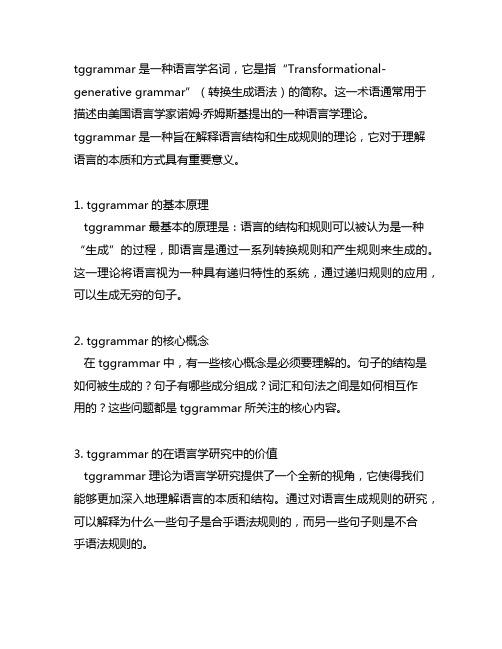
tggrammar是一种语言学名词,它是指“Transformational-generative grammar”(转换生成语法)的简称。
这一术语通常用于描述由美国语言学家诺姆·乔姆斯基提出的一种语言学理论。
tggrammar是一种旨在解释语言结构和生成规则的理论,它对于理解语言的本质和方式具有重要意义。
1. tggrammar的基本原理tggrammar最基本的原理是:语言的结构和规则可以被认为是一种“生成”的过程,即语言是通过一系列转换规则和产生规则来生成的。
这一理论将语言视为一种具有递归特性的系统,通过递归规则的应用,可以生成无穷的句子。
2. tggrammar的核心概念在tggrammar中,有一些核心概念是必须要理解的。
句子的结构是如何被生成的?句子有哪些成分组成?词汇和句法之间是如何相互作用的?这些问题都是tggrammar所关注的核心内容。
3. tggrammar的在语言学研究中的价值tggrammar理论为语言学研究提供了一个全新的视角,它使得我们能够更加深入地理解语言的本质和结构。
通过对语言生成规则的研究,可以解释为什么一些句子是合乎语法规则的,而另一些句子则是不合乎语法规则的。
4. 个人观点和理解从我个人的观点来看,tggrammar理论是一种非常有用的理论框架,它为我们提供了一种新的思考方式和研究语言的工具。
通过深入研究tggrammar理论,我相信我们可以更好地理解各种不同语言之间的共性和差异,从而为跨文化交流和语言教育提供更好的理论基础。
总结回顾:tggrammar理论是一种旨在解释语言结构和生成规则的理论,它强调语言生成的过程和递归规则的应用。
通过深入研究tggrammar理论,我们可以更好地理解语言的生成和语法规则,为语言学研究和语言教育提供更好的理论基础。
tggrammar理论是一种语言学理论,它的基本原理是语言的结构和规则可以被认为是一种“生成”的过程。
语言学重要概念梳理(中英文对照版)

语⾔学重要概念梳理(中英⽂对照版)第⼀节语⾔的本质⼀、语⾔的普遍特征(Design Features)1.任意性 Arbitratriness:shu 和Tree都能表⽰“树”这⼀概念;同样的声⾳,各国不同的表达⽅式2.双层结构Duality:语⾔由声⾳结构和意义结构组成(the structure ofsounds and meaning)3.多产性productive: 语⾔可以理解并创造⽆限数量的新句⼦,是由双层结构造成的结果(Understand and create unlimited number withsentences)4.移位性 Displacemennt:可以表达许多不在场的东西,如过去的经历、将来可能发⽣的事情,或者表达根本不存在的东西等5.⽂化传播性 Cultural Transmission:语⾔需要后天在特定⽂化环境中掌握⼆、语⾔的功能(Functions of Language)1.传达信息功能 Informative:最主要功能The main function2.⼈际功能 Interpersonal:⼈类在社会中建⽴并维持各⾃地位的功能establish and maintain their identity3.⾏事功能 performative:现实应⽤——判刑、咒语、为船命名等Judge,naming,and curses4.表情功能 Emotive Function:表达强烈情感的语⾔,如感叹词/句exclamatory expressions5.寒暄功能 Phatic Communion:应酬话phatic language,⽐如“吃了没?”“天⼉真好啊!”等等6.元语⾔功能 Metalingual Function:⽤语⾔来谈论、改变语⾔本⾝,如book可以指现实中的书也可以⽤“book这个词来表达作为语⾔单位的“书”三、语⾔学的分⽀1. 核⼼语⾔学 Core linguistic1)语⾳学 Phonetics:关注语⾳的产⽣、传播和接受过程,着重考察⼈类语⾔中的单⾳。
2021年语言学家菲尔墨的三个理论探讨

语言学家菲尔墨的三个理论探讨格语法、框架语义学和构式语法层层递进并逐步拓展和延伸,下面是搜集的一篇探究语言学家菲尔墨的三个理论的,欢迎阅读借鉴。
美国着名语言学家菲尔墨(Charles J.Fillmore)的语言学理论可以分为相对 ___又相互 ___的三个阶段:20世纪60年代提出的格语法(Case Gram ___r)、70年代中后期提出的框架语义学(Frame Se ___ntics)和80年代末兴起的构式语法(Construction Gram___r)。
这些理论基本分布于其14篇主要论文中[1].Fillmore提出的这三项理论具有里程碑式的意义,分别代表了当代语言学研究的三个重要阶段:生成语法、认知语法和构式语法,对语言学的发展和走向起到了引导性作用[2].笔者试整合Fillmore的这三项理论,分析这三项语言学理论的内在逻辑。
以这三项理论的内容为基础分析理论之间的共同点和逻辑关系,指出贯穿Fillmore这三项理论的一脉相承的隐线。
格语法、框架语义学和构式语法这三项理论看似关联甚微,甚至分属不同的理论阵营,Fillmore本人也承认自己在语言观上从形式观到认知观的转变。
但是,笔者认为,Fillmore的格语法、框架语义学和构式语法在理论上是一脉相承的:格语法在底层层次上以句中动词和名词的关系为研究角度,制定动词在语法上的格框架,分析句子的深层语义;框架语义学是语义理解的新视野,提供了意义理解上的整体框架,意义是核心,框架围绕意义形成;构式语法则是在句法、语义和语用三种分析结合的基础上,对词组或句子进行词语组合意义之外的理解,也是对句子和语言现象的形式化。
三者既相互区别又层层递进,有其共同的思想基础。
Fillmore师从美国语言学家诺姆·乔姆斯基,受乔姆斯基 ___思想的影响甚深。
追根溯源,Fillmore还受到语言学开山鼻祖洪堡特和索绪尔的思想影响,因而,Fillmore的语言学理论中,不管是格语法、框架语义学还是构式语法,都有 ___思想的缩影。
范畴论的书 -回复

范畴论的书-回复
范畴论是一门抽象代数学分支,用于研究各种数学结构之间的关系。
以下是一些经典的范畴论书籍:
1. 《Categories for the Working Mathematician》:作者是美国数学家Saunders Mac Lane,这本书被誉为范畴论的经典之作,适合对范畴论有一定了解的读者阅读。
2. 《Category Theory in Context》:作者是Emily Riehl,这本书适合初学者阅读,内容涵盖了范畴论的基础知识和应用。
3. 《Basic Category Theory》:作者是Tom Leinster,这本书是一本简明扼要的入门教程,适合对范畴论完全不了解的读者阅读。
4. 《Categories and Sheaves》:作者是Kashiwara和Schapira,这本书介绍了范畴论在同调代数和微分几何中的应用,适合具有一定背景知识的读者阅读。
5. 《Sheaves in Geometry and Logic: A First Introduction to Topos Theory》:作者是Mac Lane和Moerdijk,这本书介绍了范畴论在拓扑学和逻辑学中的应用,适合具有一定背景知识的读者阅读。
语言学专业词汇中英文对照版

1语言学术语(英-汉对照)表 Aabbreviation 缩写词,略语 ablative 夺格,离格 accent 重音(符) accusative 宾格achievement test 成绩测试 acoustic phonetics 声学语音学 acquisition 习得 acronym 缩略语action process 动作过程 actor 动作者address form 称呼形式 addressee 受话人 addresser 发话人 adjective 形容词adjunct 修饰成分 附加语 adverb 副词 affix 词缀affixation 词缀附加法 affricate 塞擦音 agreement 一致关系 airstream 气流 alliteration 头韵 allomorph 词/语素变体 allophone 音位变体allophonic variation 音位变体 allophony 音位变体现象 alveolar ridge 齿龈 alveolar 齿龈音 ambiguity 歧义analogical creation 类推造字 anapest 抑抑扬格 anaphor 前指替代anaphoric reference 前指照应 animate 有生命的 annotation 注解antecedent 先行词 前在词anthropological linguistics 人类语言学anticipatory coarticulation 逆化协同发音antonomasia 换称 代类名 antonym 反义词antonymy 反义(关系) appellative 称谓性applied linguistics 应用语言学 applied sociolinguistics 应用社会语言学appropriacy 适宜性appropriateness 适宜性 得体性 approximant 无摩擦延续音 aptitude test 素质测试 Arabic 阿拉伯语arbitrariness 任意性 argument 中项 中词 主目 article 冠词articulation 发音 articulator 发音器官articulatory phonetics 发音语音学artificial speech 人工言语 aspect 体aspirated 吐气 送气 assimilation 同化 associative 联想associative meaning 联想意义 assonance 准压韵 半谐音 attributive 属性 修饰语 定语 auditory phonetics 听觉语音学 authentic input 真实投入 authorial style 权威风格 authoring program 编程 autonomy 自主性 auxiliary 助词auxiliary verb 助动词 Bbabbling stage 婴儿语阶段 back-formation 逆构词法 base component 基础部分behavioural process 行为过程 behaviourism 行为主义 bilabial 双唇音bilabial nasal 双唇鼻音bilateral opposition 双边对立 bilingualism 双语现象 binary division 二分法 binary feature 二分特征 binary taxonomy 二分分类学 binding 制约binding theory 制约论 blade 舌叶 舌面前部 blank verse 无韵诗 blending 混成法borrowing 借用 借词 bound morpheme 粘着语素 bounding theory 管辖论 bracketing 括号法brevity maxim 简洁准则 bridging 架接broad transcription 宽式音标 broadening 词义扩大 Brown corpus 布朗语料库 Ccalculability 可计算性 calque 仿造 仿造词语 cancellability 可删除 cardinal numeral 基数 cardinal vowel 基本元音 case 格case grammar 格语法 case theory 格理论 category 范畴categorical component 范畴成分 causative 使役的 使投动词 center 中心词central determiner 中心限定词 chain relation 链状关系 chain system 链状系统 choice 选择choice system 选择系统 circumstance 环境因子 class 词类class shift 词性变换 clause 小句 从句 click 吸气音 咂音 clipping 截断法 closed class 封闭类 closed syllable 闭音节 cluster 音丛coarticulation 协同发音 coda 结尾音节 符尾 code 语码 信码cognitive psychology 认知心理学 cognitive system 认知系统 coherence 相关 关联 cohension 衔接co-hyponym 同下义词 colligation 类连结collocative meaning 搭配意义 color word 色彩词。
universalgrammar名词解释英语

Universal grammar名词解释英语Universal grammar名词解释:普遍语法,是美国语言学家乔姆斯基语言理论中的一个术语。
乔姆斯基认为,语言是创造的,语法是生成的。
儿童生下来就具有一种普遍语法。
普遍语法实质上是一种大脑具有的与语言知识相关的特定状态,一种使人类个体足以能学会任何一种人类语言的物理机制及相应的心理机制。
特点:第一,普遍语法不是语法大全,不是像传统的普通语言学那样包罗万象;第二,它不是通用语法或万能语法,不能用来代替个别语言的语法;第三,它不是像一本实用语法那样包括各种句型、词形变化等内容的语法。
乔姆斯基说得很清楚:“普遍语法不是一部语法,而是一系列条件,用来限制人类语法的可能范围。
”普遍语法是构成语言习得者的初始状态的一组特性、条件和其他东西。
具体地说,普遍语法是一切人类语言必须具有的原则、条件和规则系统,代表了人类语言的最基本东西。
人能学会语言,是因为人脑生来就存有人类一切语言的共同特点。
这些共同特点就是普遍语法。
由于语言原则是集体无意识的内容,所以各种族、民族儿童都与生俱来,也就是说有共同的语法;由于后天语言环境不同,即所获外界刺激不同,所以才在普遍语法范围内获得各不相同的母语生成语法。
生成语法的作用是确定句子的可能范围。
普遍语法的作用是用更概括的原则来确定语法的范围。
某种语言的生成语法规则排除不合格句子,普遍语法则排除不合格的语法,普遍语法是语法的语法。
实际上,普遍语法是乔姆斯基为揭开人类习得语言的奥秘所做的假设,是假想的人类语言都要遵循的一系列抽象原则和必备的条件,是生成各种具体语言的基础体系,它不是社会规约出来的规则,而是人脑里的心智规则。
乔姆斯基的基本思想就是要制定出少量的原理,通过很少几项原理的相互作用建立起整个语法机制,为各类语法提供一个普遍性的参照。
语言学术语英汉对照
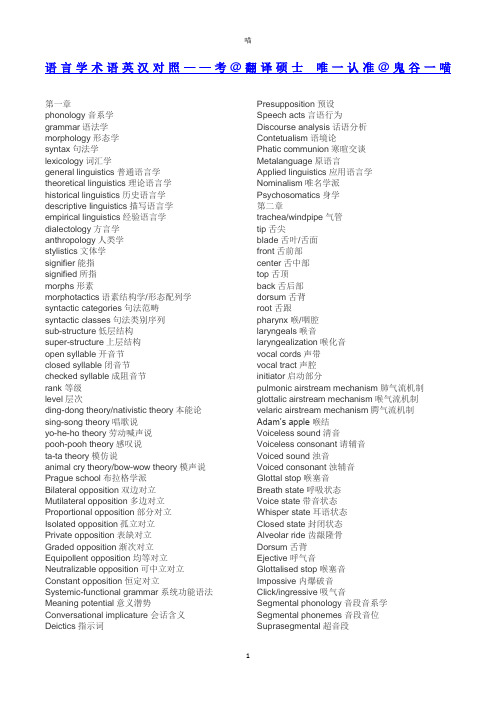
语言学术语英汉对照——考@翻译硕士唯一认准@鬼谷一喵第一章phonology音系学grammar语法学morphology形态学syntax句法学lexicology词汇学general linguistics普通语言学theoretical linguistics理论语言学historical linguistics历史语言学descriptive linguistics描写语言学empirical linguistics经验语言学dialectology方言学anthropology人类学stylistics文体学signifier能指signified所指morphs形素morphotactics语素结构学/形态配列学syntactic categories句法范畴syntactic classes句法类别序列sub-structure低层结构super-structure上层结构open syllable开音节closed syllable闭音节checked syllable成阻音节rank 等级level层次ding-dong theory/nativistic theory本能论sing-song theory唱歌说yo-he-ho theory劳动喊声说pooh-pooh theory感叹说ta-ta theory模仿说animal cry theory/bow-wow theory模声说Prague school布拉格学派Bilateral opposition双边对立Mutilateral opposition多边对立Proportional opposition部分对立Isolated opposition孤立对立Private opposition表缺对立Graded opposition渐次对立Equipollent opposition均等对立Neutralizable opposition可中立对立Constant opposition恒定对立Systemic-functional grammar系统功能语法Meaning potential意义潜势Conversational implicature会话含义Deictics指示词Presupposition预设Speech acts言语行为Discourse analysis话语分析Contetualism语境论Phatic communion寒暄交谈Metalanguage原语言Applied linguistics应用语言学Nominalism唯名学派Psychosomatics身学第二章trachea/windpipe气管tip舌尖blade舌叶/舌面front舌前部center舌中部top舌顶back舌后部dorsum舌背root舌跟pharynx喉/咽腔laryngeals喉音laryngealization喉化音vocal cords声带vocal tract声腔initiator启动部分pulmonic airstream mechanism肺气流机制glottalic airstream mechanism喉气流机制velaric airstream mechanism腭气流机制Adam’s apple喉结Voiceless sound清音Voiceless consonant请辅音Voiced sound浊音Voiced consonant浊辅音Glottal stop喉塞音Breath state呼吸状态Voice state带音状态Whisper state耳语状态Closed state封闭状态Alveolar ride齿龈隆骨Dorsum舌背Ejective呼气音Glottalised stop喉塞音Impossive内爆破音Click/ingressive吸气音Segmental phonology音段音系学Segmental phonemes音段音位Suprasegmental超音段Non-segmental非音段Plurisegmental复音段Synthetic language综合型语言Diacritic mark附加符号Broad transcription宽式标音Narrow transcription窄式标音Orthoepy正音法Orthography正字法Etymology词源Active articulator积极发音器官Movable speech organ能动发音器官Passive articulator消极发音器官Immovable speech organ不能动发音器官Lateral边音Approximant [j,w]无摩擦延续音Resonant共鸣音Central approximant中央无摩擦延续音Lateral approximant边无摩擦延续音Unilateral consonant单边辅音Bilateral consonant双边辅音Non-lateral非边音Trill [r]颤音 trilled consonant颤辅音rolled consonant滚辅音Labal-velar唇化软腭音Interdental齿间音Post-dental后齿音Apico-alveolar舌尖齿龈音Dorso-alveolar舌背齿龈音Palato-alveolar后齿龈音Palato-alveolar腭齿龈音Dorso-palatal舌背腭音Pre-palatal前腭音Post-palatal后腭音Velarization软腭音化Voicing浊音化Devoicing清音化Pure vowel纯元音Diphthong二合元音Triphthong三合元音Diphthongization二合元音化Monophthongization单元音化Centring diphthong央二合元音Closing diphthong闭二合元音Narrow diphthong窄二合元音Wide diphthong宽二合元音Phonetic similarity语音相似性Free variant自由变体Free variation自由变异Contiguous assimilation临近同化Juxtapostional assimilation邻接同化Regressive assimilation逆同化Anticipatory assimilation先行同化Progressive assimilation顺同化Reciprocal assimilation互相同化Coalescent assimilation融合同化Partial assimilation部分同化Epenthesis插音Primary stress主重音Secondary stress次重音Weak stress弱重音Stress group重音群Sentence stress句子重音Contrastive stress对比重音Lexical stress词汇重音Word stress词重音Lexical tone词汇声调Nuclear tone核心声调Tonetics声调学Intonation contour语调升降曲线Tone units声调单位Intonology语调学Multilevel phonology多层次音系学Monosyllabic word多音节词Polysyllabic word单音节次Maximal onset principle最大节首辅音原则第三章词汇liaison连音contracted form缩写形式frequency count词频统计a unit of vocabulary词汇单位a lexical item词条a lexeme词位hierarchy层次性lexicogrammar词汇语法morpheme语素nonomorphemic words单语素词polymorphemic words多语素词relative uninterruptibility相对连续性a minimum free form最小自由形式the maximum free form最大自由形式variable words 可变词invariable words不变词paradigm聚合体grammatical words(function words)语法词/功能词lexical words(content words)词汇词/实义词closed-class words封闭类词opened-class words开放类词word class词类particles小品词pro-form代词形式pro-adjective(so)代形容词pro-verb(do/did)代副词pro-adverb(so)代动词pro-locative(there)代处所词/代方位词determiners限定词predeterminers前置限定词central determiners中置限定词post determiners后置限定词ordinal number序数词cardinal number基数词morpheme词素morphology形态学free morpheme自由词素bound morpheme黏着词素root词根affix词缀stem词干root morpheme词根语素prefix前缀infix中缀suffix后缀bound root morpheme黏着词根词素inflectional affix屈折词缀derivational affix派生词缀inflectional morphemes屈折语素derivational morphemes派生语素word-formation构词compound复合词endocentric compound向心复合词exocentric compound离心复合词nominal endocentric compound名词性向心复合词adjective endocentric compound形容词性向心复合词verbal compound动词性复合词synthetic compound综合性复合词derivation派生词morpheme语素phoneme音位morphonology形态语音学morphophomemics形态音位学morphemic structure语素结构phonological structure音素结构monosyllabic单音节polysyllabic多音节phonological conditioned音位的限制morphological conditioned形态的限制coinage/invention新创词语blending混成法abbreviation缩写法acronym首字母缩写法back-formation逆序造次/逆构词法analogical creation类比构词法borrowing借词法loanword借词loanblend混合借词loanshift转移借词loan translation翻译借词loss脱落addition添加metathesis换位assimilation同化contact assimilation接触性同化contiguous assimilation临近性同化theory of least effort省力理论non- contiguous assimilation非临近性同化distant assimilation远距离同化morpho-syntactic change形态-句法变化morphological change形态变化syntactical change句法变化finite element有定成分semantic change语义变化multisemous多种意义broadening词义扩大narrowing词义缩小meaning shift词义转移class shift词性变换folk etymology俗词源orthographic change拼写的变化conversion变换/变码domain范围/领域meaning shift意义转移split infinitives分裂不定式(She was told to regularly classes)calque仿造词语clipping截断法metanalysis再分化finiteness定式proximate(this)近指代词obviative(that)远指代词non-productivity/unproductive非多产性semiotics符号学paradigmatic relations聚合关系associative relations联想关系syntagmatic relations组合关系sequential relations序列关系logogram语标register语域passive vocabulary消极词汇lexis/vocabulary词汇表第四章句法number数gender性case格nominative主格vocative呼格accusative兵格genitive属格dative与格ablative离格tense 时aspect体perfective完成体imperfective未完成体concord/agreement一致关系/协同关系government支配关系the governor支配者the governed被支配者signified能指signifier所指syntagmatic relationship组合关系paradigmatic relationship聚合关系associative relationship联想关系animate noun有生名词the two axes两根坐标坐标轴immediate constituent analysis(IC analysis for short)直接成分分析法linear structure线性结构hierarchical structure层级结构construction结构体constituent成分substituability替换性labeled tree diagram标签树形图endocentric/headed construction向心结构/中心结构exocentric construction离心结构subordinate construction主从结构coordinate construction并列结构recapitulation再现the declarative陈述句the interrogative疑问句dative movement与格移位morph-phonemic rule形态音位规则constituent morphemes成分规则affix hopping词缀越位nominalization名物化object-deletion宾语删除subject-deletion主语删除categories语类lexicon词库temporal subject表时间的主语syntactic limitation句法限制standard theory标准理论trace theory语迹理论the same index带同标志government管辖binding约束a rule system规则系统a principle system原则系统constituent command(C-command for short)成分统制plain English普通英语anaphor照应语pronominal指代语r-expression(referential-expression)指称语INFL(inflection)形态变化reciprocals(each other)相互代词accessible subject可及主语local domain局部语域binding domain约束语域logophoricity主人公视角CS(computational system)计算系统Merger合并move移动theme主位rheme述位empty subject空主语objective order客观顺序subjective order主观顺序actual sentence division实义句子切分法functional sentence perspective 功能句子观communicative dynamism (CD)交际动力bipartition二分法tripartite classification三分法representative function表达功能expressive function表情功能appellative/vocative function称呼功能conative function意欲功能poetic function诗学功能ideational function概念功能interpersonal function人际功能textual function语篇功能transitivity及物性actor动作者mood system语气系统the finite verbal operator限定部分residue剩余部分indicative直陈语气imperative祈使语气mental-process(a process of sensing)心理过程(感觉过程)relational process(a process of being)关系过程(属性过程)verbal process(a process of saying)言语过程(讲话过程)existential process生存过程第四章句法number数gender性case格nominative主格vocative呼格accusative兵格genitive属格dative与格ablative离格tense 时aspect体perfective完成体imperfective未完成体concord/agreement一致关系/协同关系government支配关系the governor支配者the governed被支配者signified能指signifier所指syntagmatic relationship组合关系paradigmatic relationship聚合关系associative relationship联想关系animate noun有生名词the two axes两根坐标坐标轴immediate constituent analysis(IC analysis for short)直接成分分析法linear structure线性结构hierarchical structure层级结构construction结构体constituent成分substituability替换性labeled tree diagram标签树形图endocentric/headed construction向心结构/中心结构exocentric construction离心结构subordinate construction主从结构coordinate construction并列结构recapitulation再现the declarative陈述句the interrogative疑问句dative movement与格移位morph-phonemic rule形态音位规则constituent morphemes成分规则affix hopping词缀越位nominalization名物化object-deletion宾语删除subject-deletion主语删除categories语类lexicon词库temporal subject表时间的主语syntactic limitation句法限制standard theory标准理论trace theory语迹理论the same index带同标志government管辖binding约束a rule system规则系统a principle system原则系统constituent command(C-command for short)成分统制plain English普通英语anaphor照应语pronominal指代语r-expression(referential-expression)指称语INFL(inflection)形态变化reciprocals(each other)相互代词accessible subject可及主语local domain局部语域binding domain约束语域logophoricity主人公视角CS(computational system)计算系统=derivational procedure推导系统Merger合并move移动theme主位rheme述位empty subject空主语objective order客观顺序subjective order主观顺序actual sentence division实义句子切分法functional sentence perspective 功能句子观communicative dynamism (CD)交际动力bipartition二分法tripartite classification三分法representative function表达功能expressive function表情功能。
英语词汇学chapter

The basic vocabulary is consistently updated and expanded as new words and expressions enter the language through changes in culture, technology, and society
• The Changes and Development of English Vocabulary
目录
• Introduction to English Lexicology
• The Composition of English Vocabulary
• The semantic relationship of English vocabulary
Middle stage: During the Middle Ages, schools begin to pay attention to the morphology and semantic changes of words, and compiled a large number of dictionaries and glossaries
Characteristics
English Lexicology is a branch of linguistics that focuses on the dynamics and complex nature of vocabulary It involves the study of word formation processes, semantic changes, and the use of words in context
Modern stage: With the development of linguistics in the 19th century, scholars have been systematically studying the structure and function of the English vocabulary from a linguistic perspective Since then, English Lexicology has gradually become an independent discipline
语言学(第七章)

➢ 五、功能解释的实质与局限 ➢ 六、当代功能语言学的内部分类 ➢ 七、韩礼德的系统功能语法 ➢ (一)学术发展阶段 ➢ 1.阶与范畴语法(scale and category
grammar) ➢ 2.系统语法(systemic grammar) ➢ 3.功能语法(functional grammar)
➢ 二、儿童的语言习得 ➢ 三、言语生成的心理机制 ➢ 四、言语理解的心理机制 ➢ 五、几种具体的言语活动的心理机制 ➢ (一)歧义句的理解 ➢ (二)写作的心理过程 ➢ (三)阅读的心理过程 ➢ 六、心理语言学研究的意义和发展趋势 ➢ (一)目的和意义 ➢ (二)发展趋势
第八节 神经语言学
➢ 一、概述 ➢ (一)神经语言学的概念和研究任务 ➢ (二)神经语言学研究的几个发展阶段 ➢ 二、言语功能的生理基础 ➢ (一)三大言语中枢:布洛卡区、韦尼克
区、角回区 ➢ (二)大脑两半球的言语功能 ➢ (三)男女的言语功能的差异
➢ 三、各种言语活动的神经机制 ➢ (一)认读词和书写词的神经机制 ➢ (二)加工和理解句子的神经机制 ➢ (三)掌握外语的神经心理机制 ➢ 四、几种言语障碍及其神经心理机制 ➢ (一)因脑部受损引起的言语障碍 ➢ (二)因发音功能失常引起的言语障碍 ➢ 1.缄默症 ➢ 2.口吃 ➢ 3.声音嘶哑五、神经语言学研究的意义、目
前的困难及发展趋势
第九节 文化语言学
➢ 一、语言与文化研究简述 ➢ (一)国外研究简述 ➢ (二)国内研究简述 ➢ 二、关于文化的理解
➢ 三、语言与文化的关系 ➢ (一)社会、文化是第一性的 ➢ (二)语言是社会、文化的一部分 ➢ 1.服饰用语反映风土人情及文化变迁 ➢ 2.服饰用语反映出社会地位 ➢ 3.服饰用语反映生产力、生活水平、文化程
基本语言与逻辑词汇英中对照表1
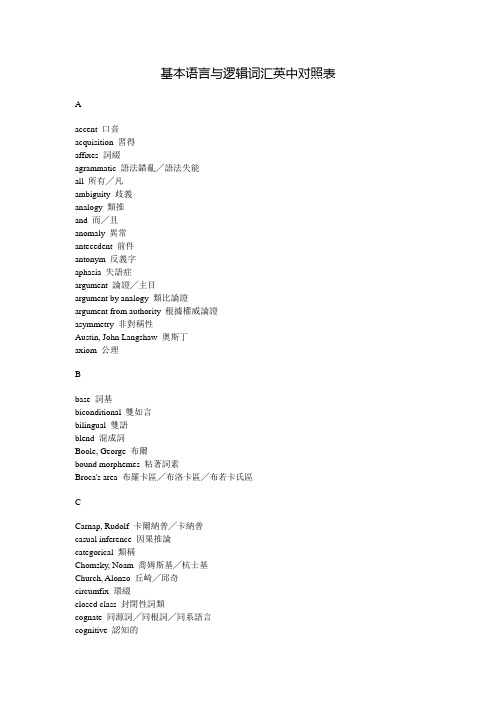
基本语言与逻辑词汇英中对照表Aaccent 口音acquisition 習得affixes 詞綴agrammatic 語法錯亂╱語法失能all 所有╱凡ambiguity 歧義analogy 類推and 而╱且anomaly 異常antecedent 前件antonym 反義字aphasia 失語症argument 論證╱主目argument by analogy 類比論證argument from authority 根據權威論證asymmetry 非對稱性Austin, John Langshaw 奧斯丁axiom 公理Bbase 詞基biconditional 雙如言bilingual 雙語blend 混成詞Boole, George 布爾bound morphemes 粘著詞素Broca's area 布羅卡區╱布洛卡區╱布若卡氏區CCarnap, Rudolf 卡爾納普╱卡納普casual inference 因果推論categorical 類稱Chomsky, Noam 喬姆斯基╱杭士基Church, Alonzo 丘崎╱邱奇circumfix 環綴closed class 封閉性詞類cognate 同源詞╱同根詞╱同系語言cognitive 認知的cohesiveness 銜接complementary 互補性compound 複合詞condition 條件conditional 如言conjunction 連言規則connotative 隱含的╱內涵的consequent 後件consistency 一致性constituent structure 成分結構constituent structure tree 成分結構樹形圖contradiction 矛盾contrafactual conditional 反事實如言content morpheme 內容詞素content words 實詞context 語境╱脈絡contingency 適真言cooperative principles 合作原則counter example 反例critical-age hypothesis 語言臨界期假說DDe Morgan, Augustus 狄.摩根╱德.摩根deductive 推論╱演繹deep structures / d-structures 深層結構deixis 指示語denotative 指示的descriptive grammar 描寫語法dialect 方言dilemma 兩難論╱兩難推理╱兩刀論法discourse 語段╱話語╱文段╱討論discreteness 離散性disjunct 選項disjunction 選言disjunctive syllogism 選言三段論domain 域╱範域Eelement 分子equivalence 等值╱等價equal 同一euphemism 婉語╱委婉語exclusive or 不可兼容的或explanation 解說explanandum 待解說項explanans 解說項Ffallacies 謬誤╱謬論free morphemes 自由詞素Frege, Gottlob 弗雷格╱弗列格function words 功能詞GGodel, Kurt 哥德爾╱戈代爾generative grammar 衍生語法╱生成語法grammar 語法grammatical category 語法范疇Hhomonym 同形同音異義字homophone 同音異形異義字human mind 人類心智hyponym 下義詞Iidentity 等同idiom 成語if 若╱如果╱假如if and only if (iff) 若且唯若╱恰好如果╱有而且只有╱有而且只當╱當且僅當implication 涵蘊inclusive or 可兼容的或inconsistency 不一致性incompleteness theorem 不完備定理inductive 歸納inductive generalization 歸納推廣inference 推演infixes 中綴Jjargon aphasia 行話失語症Llanguage universals 語言普遍性lateralization 偏側優勢lexicon 語彙lexis 詞語linguistics analysis 語言分析loan words 外來詞localization 局部化logico-linguistics analysis 語理分析Mmaterial conditional / material implication 實質如言╱實質顯示╱實質蕴涵maxims of conversation 會話準則mental dictionary 心理詞典mental grammar 心理語法meta- 後視metaphor 隱喻methodology of thinking 思考方法學metonyms 轉喻詞╱換喻詞metonymy 轉喻╱換喻╱借喻minimalist program 最簡方案modus ponens 肯定前件律╱離斷律modus tollens 否定後件律morphemes 詞素morphology 構詞學╱形態學Nnecessary 必要negated conjunction 否連言negated disjunction 否選言negation 否言negative connective 否言詞neurolinguistics 神經語言學Oor 或╱或者Pparadox 悖論╱弔詭╱詭局performative verb 施為動詞person deixis 指示語phonetics 語音學phonology 音韻學╱音系學╱語音體系phrase structure rules 短語結構規則phrase structure tree 短語結構樹形圖place deixis 地點指示語polysemy 多義詞╱一詞多義╱多種解釋postulate 公設pragmatics 語用學╱語用論predicate 述詞prefixes 前綴premise 前提prescriptive grammar 規定語法proof 證明proper subset 真子集proposition 命題psycholinguistics 心理語言學Qquantifier 量號Quine, W.V.O. 蒯因╱蒯英╱奎因RReductio ad absurdum 反證法╱歸謬法╱導謬法referent 指示對象╱指稱對象rhetoric 修辭rhetorical force 修辭用意Russell, Bertrand 羅素SSapir-Whorf hypothesis 薩丕爾-沃爾夫假說╱薩丕爾-沃夫假說scope 範圍Searle, John Rogers 塞爾╱希爾勒semantics 語義學╱語義論sentence 語句set 集set theory 集合論slang 俚語sociolinguistics 社會語言學sound 可靠╱健全split-brain patients 裂腦患者statement 敘說stem 詞干structure dependency 結構依存性subset 子集sufficient 足夠╱充分sufficient and necessary 充分必要suffixes 後綴superordinate 上義詞surface structures / s-structures 表層結構syllogism 三段論symbolize 符示╱符號化synecdoche 借代╱提喻synonym 同義字╱類義字synonymy 同義字型syntactic class 句法分類syntax 句法╱句法學Ttautology 套套邏輯╱同義反復╱恆真言╱恆真句teaching grammar 教學語法theorem 定理time deixis 時間指示語transformational rules 轉換規則transitive verb 及物動詞transposition rule / contraposition 質位同換規則truth table 直值表Uundecidable 不可決定的universal grammar 普遍語法unsound 不可靠╱不健全Vvalid 有效variable 變詞variant 變式V enn diagram 范恩圖解verb 動詞WWernicke's area 韋尼卡區╱韋尼克氏區。
语言学专业名词
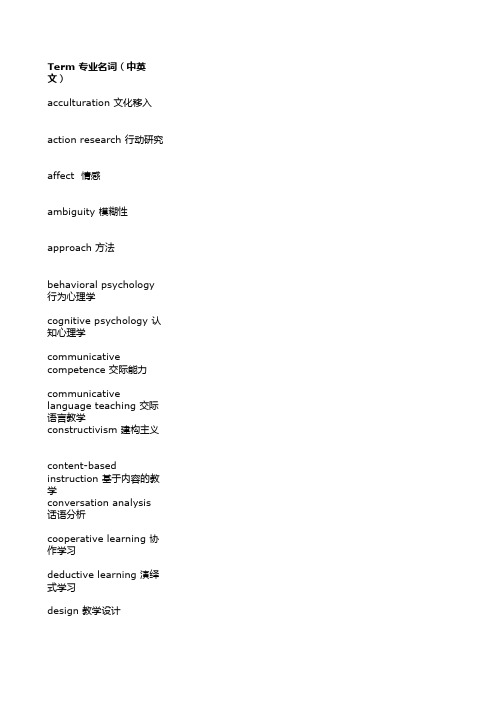
Term 专业名词(中英文)acculturation 文化移入action research 行动研究affect 情感ambiguity 模糊性approach 方法behavioral psychology 行为心理学cognitive psychology 认知心理学communicative competence 交际能力communicative language teaching 交际语言教学constructivism 建构主义content-based instruction 基于内容的教学conversation analysis 话语分析cooperative learning 协作学习deductive learning 演绎式学习design 教学设计discourse 语篇discourse competence 语篇能力drill 反复操练elicit 诱导error 偏误extrinsic motivation 外在型动机first language 第一语言或母语flooding 泛滥法fluency-first instruction 流利度教学foreign language 外语form-focused instruction 形式训练fossilization 僵化freewriting 自由式写作generative linguistics 生成语言学或转换生成语言学gist 主旨grammatical competence 语法能力hedge 推诿illocutionary force/act 言外行为impulsive learner 冲动型学习者incidental feedback 偶然型反馈inductive learning 归纳式学习informed approaches “万能式”交际学习法interference 干扰interlingual transfer 语际迁移intralingual transfer 语内迁移intrinsic motivation 内在型动机L1 第一语言或母语L2 第二语言language ego 语言自我language function 语言功能learning strategy 学习策略learning style 学习方式metalinguistic feedback 显性反馈method 方式方法motivation 动机Natural Approach, The 自然教学法noticing 目标转移overgeneralization 过度概括paralinguistic features 副语言特征pattern practice 句型操练politeness 礼貌原则pragmalinguistic competence 语用能力pragmatics 语用学proficiency 水平或能力recast 重铸,又称隐性反馈reflective learner 思考型学习者reflective style 思考型register 语域repair 修正response 反应role-play 角色扮演school of thought 学派second language 第二语言second language acquisition (SLA) 第二语言习得、简称二语习得slip 失误sociolinguistics 社会语言学sociolinguistic competence 社会语言能力sociopragmatic competence 社会语用能力stimulus 刺激strategic competence 策略能力structural linguistics 结构式语言学sustained content 持久性内容syllabus 教学计划syntax 句法target language 目标语言task-based instruction 任务型教学theme-based instruction 主题式教学Total Physical Response (TPR) 直接式沟通教学法或完全生理反应理论variability 变异性whole language 整体语言教学法Explanation 英文释义the process of adapting to a different cultureteacher-initiated classroom research focusing on a specific classroom issue(n.) emotion or feeling; (affective, adj.)a situation in which the intended meaning is not clear(n.) beliefs about the nature of language and language learning based on well-known theories(n.) a branch of psychology that focuses on observable actions, particularly stimulus-response methodsa branch of psychology that focuses on human perception and learning, in contrast with behavioral psychology which focuses on observable behaviorthe ability to communicate in a second or foreign language, requiring knowledge of social, cultural, and pragmatic rulesan approach that emphasizes interaction as both a means and the goal of learning a new languagea school of thought which integrates psychological and linguistic principles and emphasizes social interaction and the discovery, or construction, of meaningwhen a subject, such as math or history, is taught in a second language or when texts from such content areas are used for learning a second languagestudying the ways people participate in conversations and how conversation works in different settingsa learning process in which learners work togetherlearning that starts with learning language rules such as grammar, before practicing those rules(n.) the organizing principle that reflects learning theories, teaching objectives, teacher and student roles, textbooks, and materialslanguage used in particular kinds of speech and writingthe ability to connect longer sentences coherently and to produce long pieces of talk or writing(n.) a technique for practicing language, involving guided repetition to ask careful questions in order to get students to give a specific answer; (elicitation, n.)a mistake learners make when trying to say or write something above their level of languagemotivation that does not come from the learnerthe language used at home, usually in the country or region where that language is spoken; also know as the mother tongue or native languagemultiple exposures to the same language form (such as the simple past tense) within a textan approach to teaching that stresses speakinga language learned in an environment where a different language is spokenexplicit or implicit teaching which is designed to draw students' attention to formwhen the student does not show signs of progress and continues to make the same mistakesa writing activity where the focus is on flow of ideas without concern for language accuracy(n.) a school of thought that views language as a set of fixed rules that can be used to create an unlimited number of sentencesthe main idea or meaning of a written or spoken textthe ability to use the grammar, syntax, and vocabulary of a languageavoiding directness in communication in an attempt to lessen a negative effectthe speaker's intended meaninga learner who has the tendency to respond quickly, responses sometimes involve risk-taking or guessingunplanned, on-the-spot feedback and correction of errorsusing known facts or patterns to form a general rulelanguage learning approaches based on the belief that all communication supports second language acquisitionmaking mistakes in the language being learned by using the same grammatical pattern from the first languagewhen a language learner applies a rule from the first language to the second language, first language interferencewhen a learner applies a rule to all situation such as putting -ed at the end of all verbs to for the simple pastself-motivationthe first language, also know as the mother tongue or native languagethe second or additional language that one learnsthe identity people develop in reference to the language they speak the reason or purpose for saying somethinga technique a learner consciously uses when learning or using languagethe way an individual learner naturally prefers to learnteacher comments or questions used to prompt the students to self-correcta systematic plan based on a set of principles used in presenting material for instructiondesire to learn or do somethinga language teaching method based on principles of first language acquisitionbringing a student's focused attention to something such as a grammar or pronunciation pointwhen a learner applies a rule to all situationsnon-word-based communication, such as intonation or stressan exercise based on practicing the same pattern; a drillan area of pragmatics that focuses on expressing in a manner that are correct for the social situationthe appropriate use of grammatical structures to respond to a speakerthe study of how meaning is expressed and understood in interactionsa student's general ability to use a language(v.) when a teacher says an ill-formed or incomplete sentence correctlya learner who tends to think carefully before responding, making a decision, or solving a problemthe tendency to think carefully before making a decision or solving a problemthe level of formality in speaking or writingany one of a number of strategies to keep a conversation going after communication has broken down, for example, because of a misunderstandingin psychology, any behavior that is caused by a stimulus(n) a classroom activity in which students act out roles in a given situationa way of thinking that is based on a particular theorya language one learns other than one's first, or native, language: target languagea collection of theories and principles about how foreign languages are learned(n.) a language mistake that students can correct on their owna school of thought that focuses on the relationship between language and culturethe ability to use and respond to language appropriately with specific topics, people, and situationsthe culturally appropriate use of the social rules of languagein psychology, an agent that directly causes a behavior; stimuli, pl.the ability to accomplish something, such as a request, through languagea school of thought popular in the 1940s and 1950s that focused on structural characteristics of human languagewhen students study the same subject matter throughout the coursea plan that shows students what they will be studying in a particular course or subjectthe way words are arranged to form sentences or phrasesthe language that is being learnedan approach in which the focus is on the completion of meaningful tasks rather than on the languagewhen students study different themes or topics throughout a course a way of teaching in which the teacher presents language items as instructions and the students have to do exactly what the teacher tells themchange in language use at different times and in different situationsa teaching approach without explicit focus on language rules or formsChinese Explanation 中文释义适应另一种文化的过程。
CohesionandCoherence衔接与连贯

语篇的衔接手段
语篇就好比是一棵大树 —— 一个条理清 晰,上下连贯(语篇特征)的整体,那 么语篇是靠什么形成的呢?
——靠衔接手段。
What is Cohesion?
Cohesion is a semantic concept, it refers to
relations of meaning that exist within the text.(Halliday & Hasan, 1976)
•二、Substitution and Ellipsis——省略和替 代
Substitution and ellipsis are one type of cohesion device which takes different forms.
当在下面一个句子重新出现时,被省略掉,或者被其他项目所替代的现象。 例如,上例中的ones就用以替代apples,如: ⑴A. Have you been playing football?
内照应——意义依赖于上下文的词项
下照应(后照应)——意义依赖于前述词项的词项 上照应(前照应)——意义依赖于后述词项的词项
李林是我的朋友。他是武汉人。(内指,‘他’回指 前文提到的‘李林’)
我讨厌你,李林!(内指,下指‘李林’) (手指某物),那是你画的吗?(外指)
Three Types of Reference:
2) Bob says he is going to join the Labour Party. It will be interesting to see whether he does (do). (Verbal Substitution)
3) A: ‘Bruce is a good actor.’ B: ‘I don’t think so.’ (clausal substitution)
语言学词汇分类汇总

.语言学词汇分类汇总〔按字母顺序排列〕abbreviation缩写法acculturation语言文化移入acoustic phonetics声学语言学acronym词首字母缩略词address term称谓语addresser发话人addressee受话人adjacency毗邻Adjacency Condition毗邻条件Adjacency Parameter毗邻参数Affi*词缀Affi*ation加词缀法Affricate塞擦音Afro-asiatic非亚语系agreement rule一致关系规则allophone音位变体alveolar齿龈音alveolus齿龈angular gyrus角形脑回antonymy反义现象antonym反以词apocope词尾音脱落aphasia失语症aphasic失语症患者applied linguistics应用语言学arbitrariness任意性argument论元articulatory phonetics发音语音学articulatory variable发音变项aspiration送气assimilation同化appro*imation近似化auditory phonetics听觉语音学Austronesian…语系Babbling咿呀学语back-formation逆向构词法back vowel后元音Behaviorism行为主义Behaviorist learning theory行为主义学习理论Behaviorist Psychology行为主.义心理学Bilabial双唇音Bilingualism双语现象Black English黑人英语Blending混合法Borrowing借用bound morpheme黏着语素brain lateralization大脑左右半球侧化branching node分叉点broad transcription宽式音标Broca’s area布罗卡区caretaker speech保姆语case格Case Condition格条件case marking格标志causative verb使役动词central vowel中元音cerebral corte*大脑皮层cerebral plasticity大脑弹性channel渠道classical language古典语言clipping略写法closed class word封闭类词code代码code-switching代码切换cognate同源词co-hyponyms并列下义词coinage创新词color word色彩词binational rule组合规则missives承诺类municative petence交际能力parative reconstruction比拟重建法petence语言能力plement补语plement construction补足语plementarity互补性反义现象plementary distribution互补分布ple* sentence复合句ponential analysis成分分析法ponents of meaning意义成分pound word复合词pounding复合法putational linguistics计算语言学concept概念conceptualist view意念观consonant辅音constituent成分constituent structure成分构造constraint制约construction构造content word实词conte*t语境;上下文conte*tualism语境论Contrastive Analysis比照分析法conversational implicature会话含义co-operative principle合作原则coordinate sentence并列句creativity创造性critical period关键期;临界期cultural transmission文化传播declaration宣告类deep structure深层构造dental齿音derivation派生法derivational morpheme派生语素derivative派生词descriptive linguistics描写语言学design feature识别特征determiner限定词diachronic linguistics历时语言学diacritics变音符号dialect方言dialectal synonym方言同义词dichotic listening test两耳分听测试diglossia双言现象diphthong复合元音Directionalilty Parameter方位参数Directives指令类Displacement不受时空限制的特性distinctive feature区别性特征D-structure深层构造duality of structur构造二重性edouble articulation构造二重性embedded clause子句emotive meaning表情意义entailment含义entity实体epenthesis插入音Error Analysis错误分析法euphemism委婉语evaluative meaning评价意义e*pressives表达类factive predicate表达性谓词family tree谱系树feature symbol特征标记features of meaning意义特征finite clause定式字句finite verb定式动词formalize形式化fossilization语言僵化framework框架free morpheme自由语素fricative擦音front vowel前元音function word虚词functional shift功能性转换functor element起功能作用成分gender性Generative Grammar生成语法Generative Semantics生成语义学genetic predispotion基因先天条件genetic relationship亲缘关系glide滑音glottal喉音glottis声门graddabl opposites可分等级的反义词grammaticality语法性grammatical meaning语法意义Great Vowel Shift元音大变位hard palate硬腭head核心词hemispheric dominance for language大脑半球的语言优势hierarchical structure层次构造high variety高层次变体historical parative linguistics历史比拟语言学historical linguistics历史语言学holophrastic sentence独词句homography同形homonymy同音异义;同形异义homophony同音异义hyponymy下义关系hyponym下义词idiolect个人语言特点illocutionary act言外形为inconsistency自相矛盾Indo-European印欧语系infinitive marker不定式标记inflection曲折变化inflectional morpheme曲折语素input输入instrumental motivation工具性学习动机intake承受integrativ emotivation介入性学习动机interference干扰interlanguage语际语internalize在化International Phonetic Alphabet国际音标interpersonmal munication人际交际intuition语调labeled (unlabeled) tree diagram加标记树形图labial唇音LAD语言习得机制language acquisition语言习得language behavior语言行为language center语言中枢language faculty语言机制language family语系language perception语言感知language planning语言规划language variation语言变异laryn*喉la* vowel松元音level层;平面level of language语言层次le*ical category词类le*ical structure词汇构造le*icology词汇学le*icon词汇linear structure线性构造linguistic petence语言能力linguistic determinism语言决定论linguistic lateralization语言侧化linguistic performance语言运用linguistic relativism语言相对论linguistic repertoire全部语言变体linguistic taboo禁忌语linguistics语言学liquid流音loan word外来词localization定位locutionary act言行为low variety低层次变体manner of articulation发音方法matri* clause主句ma*im of manner方式准则ma*im of quality质量准则ma*im of quantity数量准则ma*im of relation关联准则.meaning意义meaningfulness有意义meaning relation意义关系mentalism心理主义mentalistic theory精神论message信息metathesis语音变位Middle English中世纪英语minimal pair最小对立对Modern English现代英语Monophthong单元音Morpheme词素morphlogical rule形态学规则morphology形态学mother tongue母语Move α移动α规则movement rule移位规则naming theory命名论narrow transcription严式音标narrowing of meaning词义缩小nasal cavity鼻腔nasality鼻音化nasalize鼻音化natural route of development 自然开展轨道negator否认词neurolinguist神经语言学家neuron神经元no-place predication空位述谓构造object宾语Old English古英语one-place predication一位述谓构造optimum age最正确学习年龄oral cavity口腔overe*tension扩展过度overgeneralization概括过度overt thought有声思维palatal腭音paralinguistic副语言学的parameter参数performance语言运用performance error语言运用错误perlocutionary act言后行为pharyngeal cavity咽腔phone音素phoneme音位phonemic contrast音位对立phonetic feature语音特征phonetics语音学phonological rule音位规则phonology音位学phrasal category词组类phrase structure rule短语构造规则pidgin洋泾浜语place of articulation发音部位plosive爆破音polysemy多义性postpone后移prepose前移postvocalic元音后的pragmatics语用学predicate谓语predication述谓构造predication analysis述谓构造分析prefi*前缀presprictive (grammar)规定语法presupposition前提proposition命题prepositional content命题容protolanguage原始语psycholinguistics心理语言学puberty青春期qualifying predication修饰性述谓构造Received Pronunciation标准发音Recursiveness循环性Reference所指语义referring e*pression所指名词register语域relational opposites关系反义词representation表达;呈现representatives阐述类response反响retrofle*卷舌音rewrite rule重写规则rounded vowel圆唇元音SAE标准美国英语sapir-Whorf hypothesis…假设second language acquisition第二语言习得segment切分成分semantic anomaly语义异体semantic deviation语义变异semantic broadening语义广义化semantic narrowing语义狭义化semantic shift语义演变semantics语义学semantic structure语义构造semantic triangle语义三角sense意义sequential rule序列规则setting背景;环境se*ist language性别歧视语sibilant咝音simple sentence简单句Sino-Tibetan汉藏语系situational dialect语域方言sociolect社会方言sociolinguistics社会语言学soft palate软腭species-specific capacity物种特有能力specifier指示语spectrograph频谱仪speech act言语行为speech munity言语社区speech variety言语变体S-structure表层构造standard language标准语stem词干stimulus刺激stop爆破音stress重音structural constituency构造成分性structural linguistics构造主义语言学subject主语subordinate predication主从述谓性构造subscript下标subvocal predication无声言语suffi*后缀superordinate上坐标词suprasegmental feature超切分特征surface structure表层构造synchronic linguistics共时语言synonymy同义词syntactic ambiguity句法歧义syntactic category句法类型syntactic rule句法规则synta*句法taboo word禁忌词target language目标语tautology同义反复teeth ridge齿龈隆骨telegraphic speech电报式言语tense and aspect时和体tense vowel紧元音tone音调;声调tone language声调语言topic话题;主题transfer转移Transformational-Generative Grammar转换生成语法transformational rule转换规则tree diagram树形图two-place predication双位述谓构造unaspirated不送气undere*tension扩展缺乏Universal Grammar普遍语法Utterance话语utterance meaning话语意义uvula小舌validity有效性variable变项. velar软腭音velum软腭vernacular本地话;本国语vocal cord声带voiced浊音化的voiceless不带音的,清音的voicing带音化,浊音化vowel元音Wernicke’s area韦尼克区widening of meaning词义扩大*-bar theory *标杆理论。
历年英语专业八级考试语言学精华汇编(1)

English英语专八学习语言学重点精华汇总一什么是语言学语言学的鼻祖要知道Saussure是Father of Modern Linguistics,他出版了一部很具代表性的著作Course in General Linguistics●语言及语言学的两个定义要清楚:Language is a system of arbitrary vocal symbols used for human communication Linguistics is a branch of science,which takes language as its object of investigation.●一些重要的对立性的概念,同学一定要区别开1.Prescriptive+Descriptive(规定一定要这样说或写+实际上我们是这么说或写)2.Synchronic+Diachronic(Saussure提出,研究某一特定时间段内的语言+研究在每一个历史阶段的语言)ngue+Parole(Saussure提出,Sociological角度出发)(一套完整的语言系统,规定了条条框框+我们现实中说的语言,按现实走,所以会变)petence+Performance(Chomsky提出,Psychological角度出发)(理想情况下说话者完全遵守语言规则+我们在现实生活中的语言运用)●Language5特征:随意性Arbitrariness(Saussure提出)+双重性Duality+多产性Productivity+移位性Displacement(语言可表达非现实的东西,如龙)+文化传播性Cultural Transmission (要靠后天学习才会掌握)●其他衍伸的学科(按字面上的理解即可)Psycholinguistics心理语言学/语言心理学、Sociolinguistics社会语言学、Anthropological Linguistics人类语言学二语音学Phonetics●定义:研究的是speech sounds,如speech production,研究的对象是Phone●国际音标图叫做the International Phonetic Alphabet/IPA chart:特别注意:什么是变音符Diacritics?是额外附加到我们所熟知的字母音标的。
pedagogical grammar名词解释
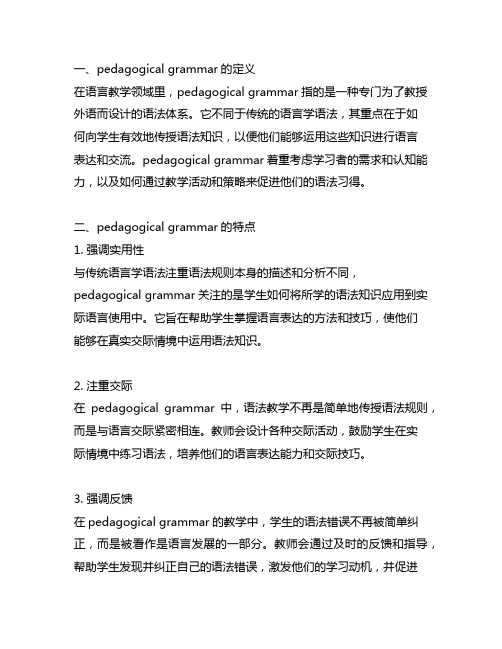
一、pedagogical grammar的定义在语言教学领域里,pedagogical grammar指的是一种专门为了教授外语而设计的语法体系。
它不同于传统的语言学语法,其重点在于如何向学生有效地传授语法知识,以便他们能够运用这些知识进行语言表达和交流。
pedagogical grammar着重考虑学习者的需求和认知能力,以及如何通过教学活动和策略来促进他们的语法习得。
二、pedagogical grammar的特点1. 强调实用性与传统语言学语法注重语法规则本身的描述和分析不同,pedagogical grammar关注的是学生如何将所学的语法知识应用到实际语言使用中。
它旨在帮助学生掌握语言表达的方法和技巧,使他们能够在真实交际情境中运用语法知识。
2. 注重交际在pedagogical grammar中,语法教学不再是简单地传授语法规则,而是与语言交际紧密相连。
教师会设计各种交际活动,鼓励学生在实际情境中练习语法,培养他们的语言表达能力和交际技巧。
3. 强调反馈在pedagogical grammar的教学中,学生的语法错误不再被简单纠正,而是被看作是语言发展的一部分。
教师会通过及时的反馈和指导,帮助学生发现并纠正自己的语法错误,激发他们的学习动机,并促进语法习得的进程。
4. 贴近学生需求pedagogical grammar将学生的语法学习需求置于教学的核心位置,教师会根据学生的语言水平、学习目标和学习风格,来设计和实施相应的教学方案和活动,使语法教学更具针对性和实效性。
三、pedagogical grammar的教学方法1. 任务型教学任务型教学是pedagogical grammar的重要教学方法之一。
在任务型教学中,教师会设计各种语言任务,要求学生运用所学的语法知识来完成任务,例如描述图片、讨论话题、模拟对话等。
通过完成任务,学生不仅可以实践语法知识,还可以在实际情境中感受语法的用途和重要性。
语言学第四章要点英语整理

语言学第四章要点(2011-10-11 21:15:48)说明:本章要点参考了多本教材,其中的X-bar theory, Universal Grammar, merger and move等部分仅供考研的同学参考。
其他同学不做要求。
第四章Syntax句法学1.Syntax定义is a subfield of linguistics that studies the sentence structure of language. Sentences are structured according to particular arrangement of words.2、Syntax as a system of rules. as a major component of grammar, syntax consists of a set of abstract rules that allow words to be combined with other words to form grammatical sentences3、Sentence structureSubject all language have ways of referring to some entity, such as a person , a place, a thing, an idea, or an event, this referring expression is grammatically called subject. A subject may be a noun or a noun phrase in a sentence that usually precedes the predicate.2.Type of sentence英语的句子中的三种基本类型是什么?Traditionally, three major types of sentences are distinguished. They are simple sentence, coordinate or compound sentence and complex sentence.A simple sentence consists of a single clause which contains a subject and a predicate and stands alone as its own sentence. For example, ① John reads extensively. the sentences contains a single clause and can stand structurally independent.A coordinate sentence并列句 contains two clauses joined by a linking word called coordinat ing conjunction, such as “and”, “but”, “or”. The two clauses in a coordinate sentence are structurally equal parts of the sentence; neither is subordinate to the other. For example, ③ John is reading a linguistic book, and Mary is preparing for her history exam.A complex sentence contains two or more clauses, one of which is incorporated into the other. The two clauses in a complex sentence have unequal status, one subordinating the other. The incorporated, or subordinate, clause is normally called an embedded clause子句, and the clause into which it is embedded is called a matrix sentence主句. For example, ⑤ Mary told Jane [that John liked linguistics]. In the above examples, the clauses in the square brackets are embedded clauses. Theyare subordinate to the clauses outside the brackets which are called matrix clauses.A complex sentence的特征:Some conclusions can be drawn from the complex sentence.1、an embedded clause functions as a grammatical unit in its matrix clause.2.most embedded clauses require an introductory word called a subordinator, such as “that”,” if ”.3.an embedded clause may not function as a grammatically well-formed sentence if it stands independently as a simple sentence unless it form changes.3、linearly- and hierarchically-structured.(线形结构和层次结构Language is a highly structured system of communication. Sentences are not formed by randomly(随意)combining lexical items, but by following a set of syntactic rules that arrange linguistic elements in a particular order to make a string of words not only meaningful but also linearly- and hierarchically-structured.(线形结构和层次结构)Hierarchical structure: the sentence structure that groups words into structural constituents and shows the syntactic categories of each structural constituent, such as NP and VP.5、Syntactic categories:句法类型1.lexical categories词类 (four major lexical categories and six minor lexical categories)2. Phrasal categories 短语类(lexical items have certain combinational properties that allow them to combine with words of different categories to form phrase. NP VP PP AP)6、Grammatical relations(语法关系) The structural and logical relations of constituents are called grammatical relations. It concerns the way each noun phrase in the sentence relates to the verb. (who does what do whom). Structural vs. logical subject, object. (**)7、Combinational rules组合规则1、Phrase structural rules The combinational pattern in a linear formula may be called a phrase structural rule, or rewrite rule. It allows us to better understand how words and phrases form sentences, and so on.2、Syntactic movement and movement rules Syntactic movement occurs whena constituent in a sentence moves out of its original place to a new position, the sentence involving which cannot be described by phrase structure rules. It was governed by transformational rules, the operationof which may change the syntactic representation of a sentence (句法的表达方式).3、什么是X-标杆理论?X-bar theory is a general and highly abstract schema that collapses all phrasal structure rules into a single format: X″→ (Spec) X (Compl). In this format, Spec stands for specifier while Compl stands for complement. This theory is capable of reducing the redundancies of individual phrasal structure rules and may well capture certain basic properties shared by all phrasal categories, i.e. NP, VP, AP, PP, across the languages of the world.4、Syntactic movement and movement rulesSyntactic movement occurs when a constituent in a sentence moves out of its original place to a new position, the sentence involving which cannot be described by phrase structure rules. It was governed by transformational rules, the operation of which may change the syntactic representation of a sentence (句法的表达方式).1 NP-movement and WH-movementNP-movement occurs when, for example, a sentence changes from the active voice to the passive voice (postpose, prepose).WH-movement is obligatory in English. It changes a sentence from affirmative to interrogative.2 Other types of movementAUX-movement (auxiliary)3 D-structure and S-structureThe syntactic component of the grammar:Phrase Structure Rules + the Lexicon (词汇)(generate)―――D-structure (deep structure) ―――Movement Rules ( transform)―――― S-structure (Surface structure) A sentence may not look different when it is at different syntactic levels. Since syntactic movement does not occur to all sentences, the D-structure and S-structure of some sentences look exactly the same at different levels of representation.4 Moreα-a general movement ruleThere is a general movement rule accounting for the syntactic behavior of any constituent movement, called Moveα(or Move Alpha), which means “move any constituent to any place”. The problem is Moveαis too powerful and the grammar should include some conditions which will restrain this power and stimulate tha t only “certain constituents” move to “certain positions”.7、Toward a theory of universal grammarSince early 1980s, Noam Chomsky and other generative linguists proposed and developed a theory of universal grammar (UG) known as the principles and parameters theory. According to Chomsky, UG is a system of linguistic knowledge and a human species-specific gift, which exists in the mind or brain of a normal human being. According to principles-and-parameters framework, UG consists of a set of general conditions, or general principles, that generate phrases and at the same time restrain the power of Moveα, thus preventing this rule from applying in certain cases. UG also contains a set of parameters that allow general principles to operate in certain ways, according to which particular grammar of natural languages vary。
汉语言文学专业英语词汇
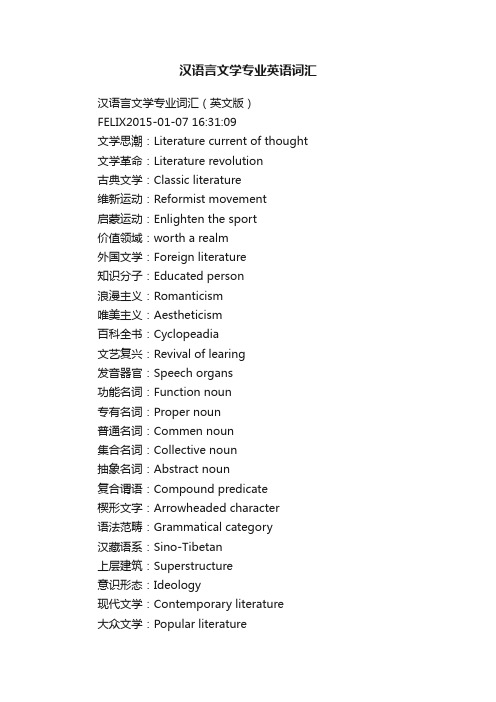
汉语言文学专业英语词汇汉语言文学专业词汇(英文版)FELIX2015-01-07 16:31:09文学思潮:Literature current of thought 文学革命:Literature revolution古典文学:Classic literature维新运动:Reformist movement启蒙运动:Enlighten the sport价值领域:worth a realm外国文学:Foreign literature知识分子:Educated person浪漫主义:Romanticism唯美主义:Aestheticism百科全书:Cyclopeadia文艺复兴:Revival of learing发音器官:Speech organs功能名词:Function noun专有名词:Proper noun普通名词:Commen noun集合名词:Collective noun抽象名词:Abstract noun复合谓语:Compound predicate楔形文字:Arrowheaded character语法范畴:Grammatical category汉藏语系:Sino-Tibetan上层建筑:Superstructure意识形态:Ideology现代文学:Contemporary literature大众文学:Popular literature报告文学:Reportage批判主义:Criticism伊索寓言:Aesop`s Fables希腊文化:Hellenism形而上学:Metaphysis孔子学说:Confucian喜怒哀乐:Pleasure Anger Sorrow Joy发源地:Source爱美剧:Amateur修辞学:Rhetoric语音学:Phonetic助动词:Auxiliary verb感叹词:Interjection连接词:Link word逻辑词:Logical word里程碑:Milestone拉丁语:Latin田园诗:Idyl无名氏:Annymous person真善美:Truth Goodness Beauty英语分类词汇:文学相关词汇classical literature 古典文学contemporary literature 现代文学popular literature 大众文学light literature 通俗文学folklore 民间文学saga (river) novel 长篇小说short novel, long short story 中篇小说short story 短篇小说love story 爱情小说deterctive story 侦破小说mystery story 怪诞小说whodunit 推理小说humorous story 幽默小说historical novel 历史小说essay 随笔book of travels 游记reportage 报告文学criticism 评论best seller 畅销书anthology 选集the complete works(of) 全集edition, printing 版masterpiece 杰作copyright 版权, 著作权deluxe binding 精装flat stitching 平装smyth sewed 线装humanities 人文学科writer 作家book 书volume 卷theatre 戏剧(美作:theater)drama 话剧comedy 喜剧tragedy 悲剧farce 滑稽剧play 剧本the three unities 三一律(一个情节,一个地点,一个时间) playwright 编剧act 幕scene 场plot 情节Appendix 1 A Glossary of Linguistic T ermsAabbreviation []n. 缩写.缩写词.略语ablative []n.夺格a.夺格的absolute []a.独立的.独立成分absolute clause 独立从句abstract nouns 抽象名词accent []n.口音.重音.(诗歌中词或音节的)重读accidence []n.1.词形变化.字形变化2. (学科的)初步.入门accommodation []n.调适.接纳accusative []a.直接宾格的n.直接宾格(受格)acoustic []a.听觉的.音响的.声学的(---feature/cue声学特征)acquisition []n.获得.习得acronym []n.首字母缩略字.缩略词active []n.主动语态actor []n.动作者.行动者(actor—action—goal)addition []n. 加.附加.添加address []n. 称呼(forms/terms of address 称呼语)addressee []n. 受话人,收信人,收件人addresser []n. 发话人,发言人,发信人.adjacency pair 相邻语对adjective []n.形容词a.形容词的adjunct []n.附加语.修饰语.修饰成分adnominal []a.(定语)修饰名词的.形容词的.形容名词的adverb []n. 副词;状语adverbial []a. 副词的,作副词用的adversative []a.反意的.相反的n.反义字(转折语) affirmative []n.肯定词.肯定语affix []n1.附加物.添加物2.字缀.词缀(affix hopping 词缀跳跃) affixation[]n. 附加.附加法.词缀附加法affricate []n.塞擦音agent (agentive) 施事agreement []n. (人称.性别.数.格的)一致airstream []n.气流alliteration []n.头韵(法)allomorph []n.同质异形体.词.语素变体allophone []n.同位音.音位变体allophonic variation 音位变体alveolar []n. 齿龈音,齿槽音.alveolar ridge 齿龈ambiguity []n.含混,歧义ambiguous歧义的anacoluthon []n.改变说法.错格.句法结构前后不一anadiplosis []n.反复法.顶真analogical []a.类似的.类推的analogical creation 类推造字anapaest []n.抑抑扬格.弱弱强格.短短长格anaphora []n. 复指.首语(句)重复法annotation []n. 注解.注释antecedent []n. (关系代词的)先行词antithesis []n. 1. 对立面;对立2. (修辞学)对语,对偶,对句antonomasia []n. 代称,称呼替换antonym []n. 反义词,反义现象aphorism []n.格言.警句.箴言aposiopesis []n.话语中断,说话中断法apostrophe []n. 1.呼语2.撇号3.省略符号4.所有格符号appellative []a.1.名称的2.通称的n.通称名词.普通名词apposition []n. 1.同位语2.并置appropriateness []n. 得体.适合.适当.相称arbitrariness []n. 任意性archaism []n.古体,拟古,古语argot []n.行语,暗语,黑话article []n.冠词articulation []n. (清楚的)发音.发出的(辅)音.发音动作articulator []n. 1.发音清楚的人或物2.发音器官articulatory []a.发音清晰的.与发音有关的aside 旁白,私语,离题话aspect []n. (动词的) 体. 时态. 时间aspirated []a.伴有h音的.送气音的.吐气.送气assimilation []n.同化aureate []a.绚丽的(-- diction,绚丽辞令–style绚丽体)assonance []n. 1. 谐音2. (诗的)准押韵.半谐音attributive []a. 1.归属的.属性的2.定语的n.定语auxiliary []a. 辅助的.附属的.从属的n.助词auxiliary verb 助动词Bback-formation 逆构词法base form 基础形式base component 基础部分basic form 基本形式behaver 行为者behavioural process 行为过程behaviourism 行为主义bilabial []a.双唇音的n. 双唇音bilabial nasal 双唇鼻音bilateral []a.双边的.双边音bilateral opposition 双边对立bilingualism [] n.双语现象binary []a. 二元的.由二部分构成的(-- feature 二分特征) binomial []a. 二项式的n.二项式blade []n.舌叶.舌面前部blank verse 无韵诗bleaching []n.词义淡化blending []n.混合.混成法.裁切block language 块语、标题式语言(有限语境中使用缩略结构如No smoking) borrow(ing) 借用.借词bound clause粘附句bound morpheme 粘着语素bounding theory 界限理论bracketing 括号法broad transcription 宽式音标broadening 词义扩大Ccalque []n.语义转借.译借vt.转借(语义).仿造语cardinal[]n基数词cardinal vowel 基本元音category []n范畴(categorical component 范畴成分)causative []a.使役的n.使役动词cavity []n.腔clause 小句.从句click 吸气音.咂音clipping []n.缩略closure []n.关闭.闭塞cluster []辅音丛coarticulation 协同发音coda []n.节尾.韵尾code 语码.信码cognate []n.同源词.同根词.同系语言cognitive psycholinguistics 认知心理语言学cognitive psychology 认知心理学cognitive system 认知系统coherence 连贯.相关.关联cohension 衔接collapse [] 叠合collective []n.集合名词colligation []n. 概括.搭连collocation []n.组合.搭配command []命令(句)commissive 承诺语common普通的.共同的(--- core 共核)(--- noun 普通名词)comparative [] a比较的.比较级的competence []n.语言能力complement(ation) 补语complementary互补.相反component 组成部分,成分componential 组成部分的composition 组构compound(ing) 复合;复合词(句)conative []a. 意动的concord []n. 协调.一致(关系)conditional []n.条件句.条件语congruence []n.重合conjugate []vt.列举(动词)的词形变化conjunct []a. 连接副词conjunction []n.连词.连接词connotation []n.含蓄.言外之意【逻】内涵consonant[]n.辅音.辅音字母a.辅音的constative []a. 陈述的.表述的constituent []n.成分.结构成分construction (construct) 构建content (ive) 内容.实义(词)contrast(ive) 对立.对比convention(al) 常规;规约conversation 会话conversationalconversion 类转.变换coordinate /coordination/coordiative 并列copula []n.系词copulative []a.连系的.作系词的n.系词co-referential(ity) 同指coronal []n.舌冠(音).舌尖音corpus []n. 1.文集.全2..躯体(尤指尸体) 3.语料语料库.素材corpora[] (corpus的复数)correlative []a.相关的n.关联词count [] 可数的,countable/uncontable 可/不可数名词couplet []n. 对句.双韵covert []隐性的Ddactyl []n. (英诗的)扬抑抑格.长短短格dative []a.与格的n.与格.与格语dative movement 与格移动declarative []a. 1. 宣言的.布告的.申报的.陈述的2.陈述的decode []vt. 译解(密码)deductive []a. 推论的.演绎的defeasibility 消除可行性definite []a.1. 明确的.确切的2. 一定的.肯定的3. 限定的deictic []a. 直证的.直指的(deixis)denotation []n. 1. 意义.本义2. 表示3. 名称.符号dental []a. 齿音的n.齿音dentalization 齿音化derivation []n.诱导.来历.起源调查.语言derivational []a.诱导的. 衍生的;引出的determiner []n.限定词deviant []a. 越轨的n.不正常者.变异物.变体deviation 偏离;变异devoice []vt.使(有声之音)变为无声之音devoicing 清音化diachronic []a.历时的diachronic linguistics 历时语言学diacritic []a.有区别的.能区分的.辨别的n.区别发音符号dialect []n. 方言.土话dialectology 方言学diphthong []n.双元音.复合元音direct object 直接宾语direct speech直接言语discourse []n.语段.语篇;话语discrete []a. 1. 分离的.不连接的2.抽象的disjunction []n. 分离.分裂displacement []n.移位.置换.取代dissimilation []n. 1. 异化2.异化作用3.异化distinguish []vt.区别.识别把...区别分类distinguisher 辩义成分domain []n. 领域.范围dorsal []a.背部的.背侧的舌背音.舌中音dorsum []n.背.背状部分.舌面(舌尖以后之部分)dual []n. 1. 双数2. 双数词dualistic []a. 二元的.二元论的duality 二重性Eejective []a. 喷出的.外射的n.外爆音ellipsis []n.省略.省略部分elliptic(al) []a. 1. 椭圆的2.省略的encode []vt. 1. 把...译成电码(或密码)endocentric []a.向心的.内向的epenthesis []n.增音.插入字母epithet []n. 1. 表示特征的修饰词2. (描述性的)称号equipollent[]a.相等的n. 相等物equivalence 相等equivoque []n. 双关语.模棱两可的词句.语义双关euphemism []n.. 婉转说法.委婉(词)语euphony []n. 声音的和谐.谐音.悦耳语音exocentric []a. 外心的。
语言学 术语翻译及术语解释

术语翻译及术语解释汇总术语翻译1.Design features of language(语言的甄别特征)Arbitrariness(任意性),Duality(二层性/二重性),Creativity(创造性/原创性),Displacement(移位性),Cultural transmission(文化传播),Interchangeability(可互换性)2. Functions of languagereferential 指称功能poetic 诗学功能emotive情感功能conative 劝慰功能phatic寒暄功能metalingual function 元语言功能ideational function概念功能interpersonal function人际功能textual function语篇/文本功能Informative(信息/告知功能),Performative Function(施为功能),Emotive Function(情感功能),Phatic communion(寒暄交谈),Recreational Function(娱乐功能),3. Phonetics(语音学),Phonology(音系/音位学); Morphology(形态学),Syntax(句法学);Semantics(语义学),Pragmatics(语用学)Articulatory phonetics发音语音学Acoustic phonetics声学语音学Auditory phonetics听觉语音学Psycholinguistics心理语言学Sociolinguistics社会语言学Anthropological linguistics人类语言学Computational linguistics计算语言学Applied linguistics应用语言学Neurolinguistics神经语言学4. Descriptive vs. prescriptive描写式和规定式Synchronic vs. diachronic共时和历时Langue vs. parole语言和言语Competence vs. performance语言能力和语言行为5. V ocal tract 声道(resonating cavities共鸣腔),pharynx咽腔, oral cavity口腔and nasal cavity鼻腔.其它的一些发音器官:lungs肺, windpipe(trachea)气管, vocal folds声带, larynx喉, epiglottis会厌,次声门, pharynx咽, uvula小舌, hard palate硬腭,soft palate软腭, alveolar ridge齿龈6.Consonants and vowels(辅音和元音)A. Manners of articulation发音方式B. Places of articulation发音位置7. Stop (or plosive)爆破音Fricative摩擦音Approximant近似音Lateral (approximant)边音Affricates塞擦音, trill颤音and tap 闪音Bilabial双唇音Labiodental唇齿音Dental齿音Alveolar齿龈音Postal veolar后齿龈音Retroflex卷舌音Palatal硬腭音Velar软腭音Uvular小舌音, pharyngeal咽音glottal声门音monophthong vowel: 单元音diphthongs双元音triphthongs三元音Lax vowels短元音Tensed vowels长元音8.Coarticulation and phonetic transcription协同发音和标音anticipatory coarticulation先期协同发音perseverative coarticulation后滞协同发音. broad transcription宽式标音narrow transcription严式标音9. minimal pairs最小对立体Phoneme音位phonemic transcriptions音位转写phonetic transcriptions语音转写phones音子allophones音位变体complementary distribution互补分布phonetic similarity发音近似性Free variation自由变体assimilation同化regressive assimilation逆同化progressive assimilation顺同化phonological rule 音系规则Epenthesis增音binary 二分的Distinctive features区别特征Endocentric and Exocentric Constructions向心结构和离心结构subordinate and coordinate从属和并列Conceptual meaning概念意义Associative meaning:联想意义Connotative meaning内涵意义Social meaning社会意义Affective meaning情感意义Reflected meaning反射意义Collocative meaning搭配意义Thematic meaning主位意义denotation: 外延意义connotation: 内涵The referential theory:指称理论Semantic triangle语义三角Sense and reference:涵义和指称Synonymy同义关系Antonymy反义关系Hyponymy上下义关系Polysemy一词多义关系Homonymy 同音/形异意关系Dialectal synonyms 地域同义词Stylistic synonyms风格同义词Collocational synonyms搭配同义词gradable antonymy 等级反义关系cover term覆盖项Marked vs. unmarked terms标记项和非标记项complementary antonymy 互补反义关系converse antonymy 逆向反义关系homophones: 同音异义词homographs : 同形异义词complete homonyms semantic components语义部分术语解释1.Design feature的定义:the defining(最典型的,起决定作用的)properties ofhuman language that distinguish it from any animal system of communication. 2.Synchronic共时:It refers to the description of a language at some point of timein history.3.Diachronic历时:It studies the development or history of language. In otherwords, it refers to the description of a language as it changes through time .4.prescriptive规定式:A kind of linguistic s tudy aims to lay down rules for “correctand standard” behavior in using language.5.descriptive描写式: A kind of linguistic study aims to describe and analyze thelanguage people actually use.6.Arbitrariness(任意性):By saying that “language is arbitrary”, we mean thatthere is no logical connection between meaning and sound.7.Duality(二层性/二重性):it means that language is a system, which consists oftwo levels of structures, at the lower level there is the structure of sounds; at the higher level there is the structure of meaning.8.Displacement(移位性): it means that language can be used to communicateabout things that are not present in our immediate communicational context.petence语言能力:it refers to an ideal speaker’s knowledge of the underlyingsystem of rules in a language.10.Performance语言行为: it refers to the actual use of the language by a speaker ina real communicational context.ngue语言: it refers to the speaker’s understanding and knowledge of thelanguage that he speaks.12.Parole言语: it is the actual speaking of language by an individual speaker.13.Cultural transmission(文化传播):It refers to the fact that the details of thelinguistic system must be learned anew(重新,再)by each speaker. Language is not transmitted biologically from generation to generation.14.Phatic communion(寒暄交谈):it refers to ritual exchanges, exchanges that havelittle meaning but help to maintain our relationships with other people.15.Phonetics(语音学): it is the study of the characteristics of speech sounds andprovides methods for their description, classification and transcription.16.V owels元音:the sounds in the production of which no articulators come veryclose together and the air-stream passes through the vocal tract without obstruction.17.Consonants辅音:The sounds in the production of which there is an obstructionof the air-stream at some point of the vocal tract.18.Phonology: it is the study of the sound systems of languages and it is concernedwith the linguistic patterning of sounds in human languages. And it studies the way in which speakers of a language systematically use a selection of these sounds in order to express meaning.19.Phoneme音位: the smallest unit of sound in a language which can distinguish twowords.20.Allophone音位变体: it refers to the different forms of a phoneme.21.Assimilation: it is a process by which one sound takes on some or all thecharacteristics of a neighboring sound.22.Coarticulation: a kind of phonetic process in which simultaneous or overlappingarticulations are involved.plementary distribution互补分布:when two sounds never occur in thesame environment, they are in complementary distribution.24.Free variation自由变体: if two sounds occurring in the same environment do notcontrast, that is, the substitution of one for the other does not produce a different word form, but merely a different pronunciation of the same word, then the two sounds are in free variation.25.Distinctive features区别特征:A phonetic feature which distinguishes onephonological unit, especially one phoneme, from another.26.minimal pairs最小对立体----- which can be defined as pairs of words whichdiffer from each other by only one sound.27.vowel glides滑音: The vowels involving movement from one sound to anotherare called vowel glides.28.Epenthesis增音:it means a process of inserting a sound after another sound.29.Substitution relation: it refers to the relation specifically between an individualunit and others that can replace it in a given sequence.30.Endocentric construction is one whose distribution is functionally equivalent, orapproaching equivalence, to one of its constituents, which serves as the centre, or head, of the whole.31.Exocentric construction: a group of syntactically related words where none ofthem is functionally equivalent to the group as a whole, that is, there is no definable center or head inside the group32.Reference: it is the relationship between words and the objects, actions orproperties that the words stand for. It deals with the extra-linguistic relationships between words and expressions and the world they describe.(具体的物质性的东西)33.Synonymy :It refers to the sameness sense relations between words.ponential analysis :Componential analysis defines the meaning of alexical element in terms of semantic components语义部分.35.Sense: it refers to the complex system of relationships that hold between linguisticelements themselves, it is concerned only with intra-linguistic relations.(概念性的东西)36.Semantics:semantics is the study of the meaning of linguistic units, words andsentences in particular.37.Homonymy: the phenomenon that words having different meanings have the sameform, i.e., different words are identical in sound or spelling, or in both.38.Antonymy:It refers to the oppositeness sense relations between words.39.Hyponymy上下义关系:Hyponymy indicates sense inclusiveness. The upperterm in this sense relation is called superordinate上义词,and the lower terms, hyponyms下义词, members of the same class are called co-hyponyms.。
- 1、下载文档前请自行甄别文档内容的完整性,平台不提供额外的编辑、内容补充、找答案等附加服务。
- 2、"仅部分预览"的文档,不可在线预览部分如存在完整性等问题,可反馈申请退款(可完整预览的文档不适用该条件!)。
- 3、如文档侵犯您的权益,请联系客服反馈,我们会尽快为您处理(人工客服工作时间:9:00-18:30)。
1.1
Quantum graphs
Let B be a bistochastic matrix representing a directed graph, i.e. two vertices xi and xj are linked iff Bij = 0. B is said unistochastic if it exists an unitary matrix U such that Bij = |Uij |2 . In this case, we
1 2000 Mathematics Subject Classification: 16W30; 05C20; 05C90; 60J99; 81Sxx. Key words and phrases: Coassociative coalgebra, Markov L-coalgebra, quantum graphs, De Bruijn graphs, periodic orbits, chaotic map, random walks, Hadamard walk.
2. For all y ∈ I ,
x ∈ f −1 ( y )
1 = 1, f ′ (x)
where f ′ is the right derivative, (defined almost everywhere on I ). 3. The finite transfer matrix B , describing the action of f on the cells Ei is unistochastic.
Remark: The Kolmogorov-Sinai-entropy of the Markov chain generated by the bistochatsic matrix B [8] is
M M
HKS = −
p ˜i
i=1 j =1
Bij log Bij ,
M
˜i = 1. This equation gives where p ˜ is the normalized left eigenvector of B such that p ˜B = p ˜, with i=1 p the dynamical entropy of the system since the Markov partition on M equal cells is a generating partition 1 of the system. As the transition matrix is bistochastic, all the components of p ˜ are equal to M . Thus ′ HKS = 0 iff all the Bij ∈ {0, 1}. This entails that |f (x)| = 1, i.e. the system is regular. With the conditions stated above, the converse is true.
arXiv:quant-ph/0209100v2 17 Oct 2002
Campus de Beaulieu, 35042 Rennes Cedex, France, philippe.leroux@univ-rennes1.fr
Abstract: This work will be devoted to the quantisation of the classical Bernoulli random walk over Z. As this random walk is isomorphic to the classical chaotic dynamical system x → 2x mod 1 with x ∈ [0, 1], we will explore the rˆ ole of classical periodic orbits of this chaotic map in relation with a non commutative algebra associated with the quantisation of the Bernoulli walk. In particular we show that the set of periodic orbits, PO, of the map x → 2x mod 1 can be embeded into a language equipped with a coassociative grammar and for any fixed time, that any vertex of Z is in one to one with of a subset of PO. The reading and the contraction maps applied to these periodic orbits allow us to recover the combinatorics generated by the quantum random walk over Z
−1 i Remark: On each cell, f concides with the function fi : [ iM , M) − → I , x → ci x + bi where the ci have to be non zero integers and the bi are rational. The unistochastic matrix B is a M by M matrix 1 . Thus the probability of visiting the cell Ej from Ei is equal to f ′1 and Bij = |c (x) , with x ∈ Ei and i| f (x) ∈ Ej .
1
say that the graph can be quantized. The notion of quantum graphs were introduced as a toy model for studying quantum chaos by Kottos and Smilansky [11], [12]. This notion was also studied by Tanner [19] and by Barra and Gaspard [2] [3]. In this article we will follow another appraoch leading to quantum graphs puts forward in [18] concerning the one dimensional dynamical systems. They consider an onedimensional mapping f acting on I = [0, 1] such that f : I − → I , is piecewise linear. Moreover f verifies the following three conditions:
1
1 0. 0
1
0
0.5
In the sequel we will be interested by one of the simplest 1D maps displaying chaotic dynamics.
2
Example 1.2 [Chaotic system, the Bernoulli shift] The Bernouilli shift is described by f : x → 2x mod 1. This map is associated with the unistochastic 1 1 1 matrix B2 = 2 . 1 1
1
Introduction and Notation
Motivated by the success of classical random walks and chaotic dynamical systems, we study the quantisation of the random walk over Z and its relationships with a classical chaotic system x → 2x mod 1 with x ∈ [0, 1] . The first part will be devoted to notation and to the introduction of notions required in the sequel. We recall the notion of quantum graphs, unistochastic processes, directed graphs and extension, L-coalgebras and coproducts, the relation between the Bernoulli walk and the map x → 2x mod 1 and a quantisation of this walk proposed by Biane [4]. Section 2 displays the relationships between some coassociative coalgebras, chaotic maps x → nx mod 1, with n > 1 and (n, 1)-De Bruijn graphs. Section 3 yields a bridge between quantum channels and quantum graphs. Section 4 defines the quantum random walk over Z and section 5 explains the link between periodic orbits of x → 2x mod 1, their coassociative language and the combinatorics generated by the quantum random walk over Z.
